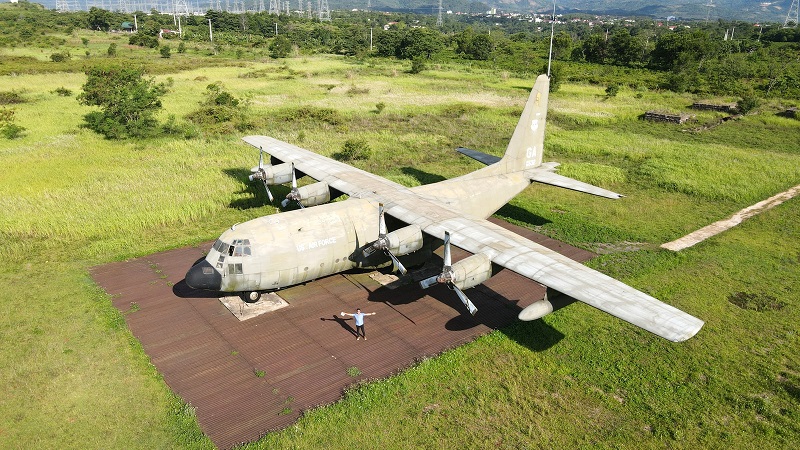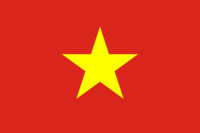Ta Con Airport, an Outdoor Historical Site in Quang Tri
Ta Con Airport is the name given to a cluster of strategic military outposts established by the U.S. military during the years 1966-1968. It played a vital role in the Khe Sanh defensive complex. Today, the Ta Con Airport site has become a popular tourist attraction, as it preserves many historically significant artifacts that are rarely found elsewhere in Vietnam. Let’s explore Ta Con Airport with Quang Tri Tourism.
This location is closely associated with the 1968 Khe Sanh liberation campaign. The historical site is now situated in Hoa Thanh hamlet, Tan Hop commune, Huong Hoa district, more than 400 meters northeast of Truong Son Road (Route 14 connecting Khe Sanh to Huong Lap), and about 3 kilometers north of the district center, Huong Hoa Town – Khe Sanh Township. The site was designated a national heritage site by the Ministry of Culture, Sports, and Tourism under Decision No. 236/QD-BVHTT on December 12, 1986.
default
Aircraft Relics at Ta Con Airport Learn About Khe Sanh, Home to Ta Con Airport Khe Sanh is a valley shaped like a basin surrounded by hills on a plateau at an altitude of 800 meters, covering approximately 60 hectares. Located near the border and strategically situated on National Highway 9, connecting Dong Ha in Vietnam with southern Laos, Khe Sanh had significant military importance not only in the Quang Tri region but also in the entire Indochina theater. Therefore, in early 1964, shortly after assuming the position of Commander of U.S. forces in Vietnam, four-star General Oetmolen hurriedly flew to Quang Tri to inspect the Khe Sanh area. From the outset, the American general recognized the strategic importance of this land.
According to Oetmolen, the United States could establish a military stronghold in Khe Sanh as a “hardened bulwark” with exceptional strategic significance for defense, blocking the western part of the Trị Thiên battlefield. It would serve as a “western anchor” for the strategic defense system in the non-military zone, turning Khe Sanh into a patrol base to intercept enemy forces from Laos along Route 9. It would also become a base for sabotage operations to disrupt the main forces of the Viet Cong and disrupt, cut off the Ho Chi Minh Trail.
Starting from 1965, the U.S. military repeatedly used chemical defoliants in the Hướng Hóa mountainous region, along with sweeping operations and the relocation of 5,000 people living on both sides of Route 9 to concentration areas in Ta Con and Làng Vây. In early 1966, the U.S. and its allies established a defensive line along Route 9 from Đông Hà to Laos by bolstering U.S. troops and allied forces with weapons, equipment, and technology to build strong firepower points along the entire strategic corridor of Route 9, including Đông Hà, Cam Lộ, Tân Lâm, Đầu Mầu, Đakrông, Khe Sanh, Ta Con, Làng Vây, and Huội San. Among these, the Khe Sanh stronghold was considered a “deadly trap” awaiting the “Communists.” By the end of 1967, about 6,000 U.S. Marine Corps troops had arrived in Khe Sanh.
Ta Con compound, located north of Route 9, was a central area constructed on a large scale, stretching 2 kilometers long and 1 kilometer wide. It included many smaller strongholds with dense and solid constructions, along with a large-sized airfield (Ta Con Airport) used for taking off and landing of armed aircraft, transport aircraft, and jet fighters. The airport covered an area of about 10,000 square meters within the base, featuring a runway paved with thousands of tons of aluminum and iron planks. Within the airport area, there was a command headquarters, an airport control tower, a communication center, and an extensive defensive infrastructure. Outside, there was a complex web of zigzagged zinc fences and large minefields.
With such an arrangement, Ta Con Airport and the adjacent high points formed an interconnected, flexible defense position that the U.S. regarded as the “toughest” within the entire Khe Sanh stronghold system. Here, the U.S. deployed its 26th Marine Regiment, an artillery battalion, a tank company, and eight company-sized security force units for occupation, support, and reconnaissance during combat. Alongside these, several military bases were constructed on surrounding high points such as Hills 689, 682, 845, 832, and 1009 (Ðộng Tri).
To the southwest and southeast of Ta Con were the administrative district of Hướng Hóa and the Làng Vây stronghold. The U.S. forces regularly had four Marine Corps battalions, artillery units, armored units, and allied troops with a substantial amount of military, technical, and logistical resources. This was not to mention the maximum support from artillery units, the air force, including B-52 strategic bombers from the 7th Fleet on Guam.
To thwart the ambitious plans of the U.S. and its allies, the 9th Route Campaign was launched with a guerrilla attack on a convoy of transport vehicles on the Tan Lam – KLu road on January 13, 1968. This attack destroyed 9 military vehicles and killed 100 American personnel. On January 18, we fought at Hills 845 and 832 (in the Ta Con area). On the night of January 20, our forces launched a surprise attack on the Khe Sanh stronghold, marking the beginning of Phase 1 of the Khe Sanh liberation campaign. On January 21, we annihilated the Hướng Hóa military complex. On January 23, we captured Huội San and initiated the siege of Ta Con. On the night of February 7, 1968, Hướng Hóa armed forces and the 24th Regiment (324th Division) launched an offensive to liberate Làng Vây.
Starting from February 8, 1968, our armed forces entered Phase 2 of the campaign: the encirclement and assault on the Ta Con stronghold. With the slogan “Turn Khe Sanh into the imperialists’ earthly hell” and the tactic of “encircle, press, advance, destroy, and eliminate the enemy stronghold,” sniper teams were actively engaged, and our artillery alternated between bombardment and surveillance, keeping U.S. troops in a constant state of tension. The enemy had to use aircraft to airdrop supplies of food, water, and ammunition. U.S. soldiers were confined to tight bunkers and tunnels in the strongholds, afraid to venture out due to the fear of sniper fire. Even supply aircraft were unable to breach the Liberation Army’s anti-aircraft defenses. Ta Con truly became an “electric chair” and a “madhouse” for the U.S. and its allies. The fear of a “second Điện Biên Phủ” haunted the U.S. Military Command, forcing them to issue orders to launch carpet bombing and send troops to rescue Khe Sanh. At the Pentagon, President Johnson ordered General Taylor to set up a “situation room” to monitor the situation in Khe Sanh and instructed U.S. Joint Chiefs of Staff to commit to holding Khe Sanh at any cost.
See more: Vietnamese DMZ
Faced with the risk of annihilation, on April 1, 1968, the U.S. and its allies conducted Operation “Ngựa bay” (Flying Horse), a large-scale military relief operation to rescue Khe Sanh, involving an airborne division, a strategic reserve division, and a special forces battalion, including a total of 17 battalions (with 13 American battalions). Our main forces still held nine battalions on the Khe Sanh front and entered Phase 3 of the campaign, shifting the focus to the destruction of the enemy command and continuing the encirclement of Ta Con. After 47 days and nights of being surrounded and attacked by our forces, the enemy was unable to save Khe Sanh, and the encirclement of Khe Sanh tightened even further. On June 26, 1968, U.S. forces were forced to withdraw from Khe Sanh.

The relentless encirclement and continuous offensive, which ultimately led to the decisive victory of our forces and people, shattered the strongest defensive system of the U.S. and its allies along Route 9. This included the Khe Sanh stronghold, despite its robust construction, formidable firepower, and large number of troops. The victory at Ta Con significantly contributed to the glorious triumph of our forces on the Route 9 – Khe Sanh front, marking the stalemate of the U.S. and its allies in strategic defense as well as the high level of development of our liberation army in strategic direction, tactics, and execution of large-scale, long-lasting offensives, with close coordination between different branches of the military.
After the disastrous defeat in 1968, starting from 1969, the U.S. and its allies aggressively concentrated forces on sweeping operations in the liberation areas of our forces and reinforced their military bases along Route 9. In early 1971, the U.S. and its allies launched Operation “Lam Sơn 719,” continuing to develop Ta Con into a large base (including a military airfield) within the Khe Sanh stronghold system to provide effective support for the purpose of “strangling” the transportation system and cutting off the second supply route (Western Trường Sơn) to the southern battlefield. With the goal of capturing Sê Pôn, Sa Di, Mường Nòng, advancing into Savanakhet, and then descending into the A Sầu and A Lưới areas to pave the way for the deep penetration of U.S. forces into Laos, the U.S. and its allies mobilized more than 3,000 South Vietnamese troops, 1,500 combat aircraft, over 800 helicopters, more than 600 armored vehicles, and nearly 300 artillery pieces for the campaign. However, after more than a month of grandstanding, the military operation was defeated by our forces. Ta Con was frequently targeted by artillery strikes, and it eventually fell. Over a year later, during the 1972 liberation campaign to free Quang Tri, all the U.S. and its allies’ strongholds along Route 9, including Ta Con Airport, were destroyed in just 5 days (March 30 – April 3, 1972), putting an end to the positions and ambitions of the U.S. military.
From 1998, efforts to restore and preserve this site began, but due to various difficulties, there were no significant achievements. It wasn’t until the years from 2002 onwards that real progress was made in preserving this historical site. Today, within the Ta Con Airport site, there is a museum, several bunkers, fortifications, and runways that have been reconstructed. It also features large artifacts such as aircraft, helicopters, artillery pieces, and tanks that are displayed to meet the tourism needs of both domestic and international visitors.
Come and explore Ta Con Airport, a place rich in history and an essential part of Quang Tri’s heritage. Witness the remnants of the past and learn about the significant events that took place here during the Vietnam War.

